The Meizu PRO 5 Review
by Matt Humrick on June 24, 2016 8:00 AM EST- Posted in
- Smartphones
- Exynos
- Mobile
- Meizu
- Exynos 7420
GPU Performance
Meizu’s PRO 5 uses a Mali-T760MP8 GPU with a maximum frequency of 772MHz for ALU-heavy workloads. Based on ARM’s Midgard architecture, the Mali-T760 is capable of outperforming Qualcomm’s previous generation Adreno 400 series GPUs at vertex processing, but falls behind in pixel processing.

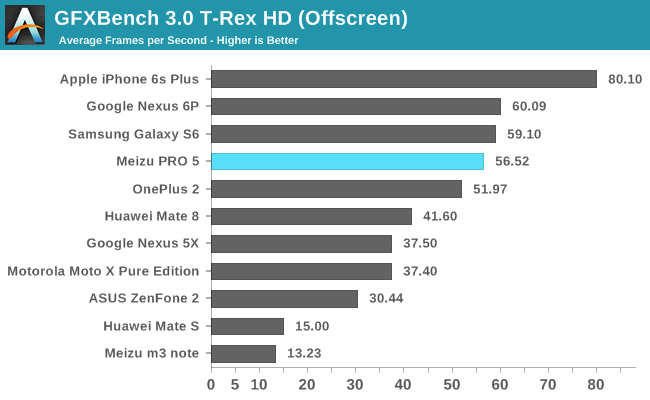
To better understand how the PRO 5 performs across a wide variety of games, we will start by looking at the OpenGL ES 2.0-based T-Rex game simulation. Because of its 1080p display, it has fewer pixels to process than the 1440p Galaxy S6, leading to better onscreen performance. Peak offscreen performance is also good, comparable to the Nexus 6P and its Adreno 430 GPU.
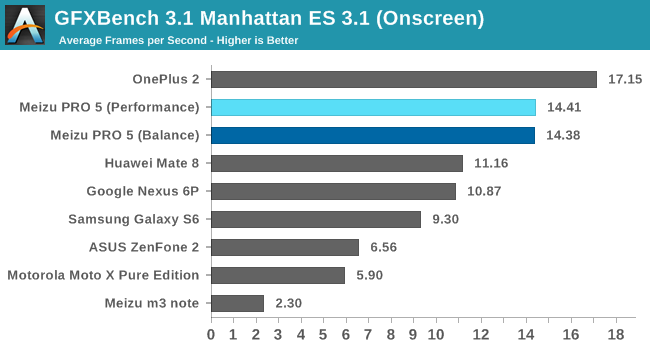
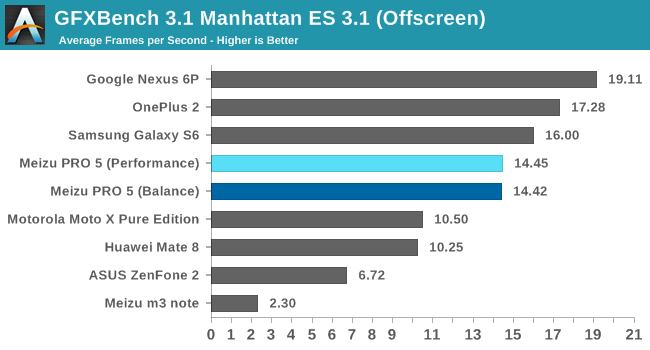
The GFXBench 4.0 Car Chase game simulation, which uses OpenGL ES 3.1 plus Android Extension Pack (AEP) features, is part of our normal test suite; however, the PRO 5 does not support hardware tessellation and is not able to run this test, so instead we’ll fall back to using GFXBench Manhattan 3.1, which still uses OpenGL ES 3.1 but does not use any AEP features.
Starting off, the PRO 5’s results are the same for both the Performance and Balance power modes. While the different modes will have some effect on performance for games that are more CPU bound, this test is entirely GPU limited, and because the PRO 5’s power modes do not affect GPU frequency, they have no impact in this test.
In the offscreen test, the PRO 5 is about 38% faster than the Moto X Pure Edition (Adreno 418) and the Mate 8, which uses the newer Mali-T880 GPU. While the Mali-T880 includes three ALU units per core versus two ALUs per core for the Mali-T760, the Mate 8 uses only four cores where the PRO 5 uses eight. After accounting for the difference in GPU clock frequency, this gives the PRO 5 124 GFLOPS of FP32 throughput versus 108 GFLOPS for the Mate 8. And because the PRO 5 has twice as many cores as the Mate 8, it can process twice as many texels/pixels per cycle too. This also applies to Huawei’s P9, whose Kirin 955 SoC uses the same Mali-T880MP4 GPU.
In the older GFXBench T-Rex test, the PRO 5’s performance was similar to the OnePlus 2 and Nexus 6P, which both use Qualcomm’s previous generation Adreno 430 GPU. This test, however, includes many more pixel effects, which take advantage of Adreno’s superior ALU performance, giving the Nexus 6P a 32% advantage over the PRO 5. While not shown in the charts above, phones such as the LG G5, which use the latest Snapdragon 820 SoC and its Adreno 530 GPU, are about twice as fast as the PRO 5 in this test.
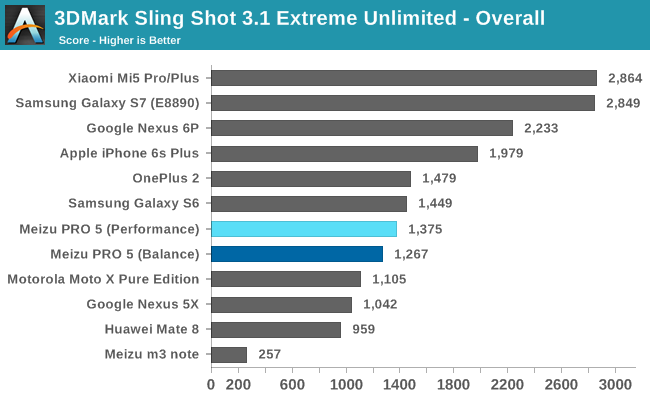
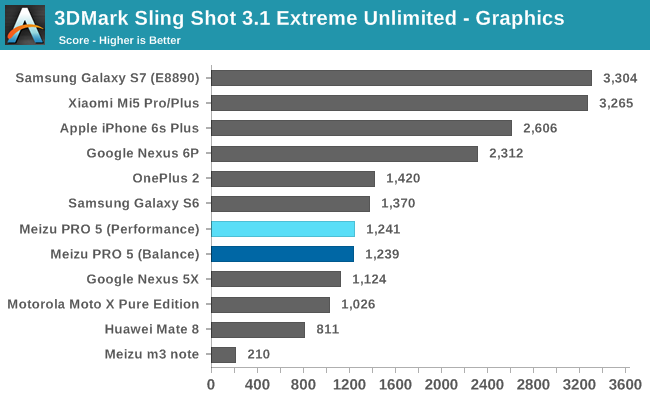
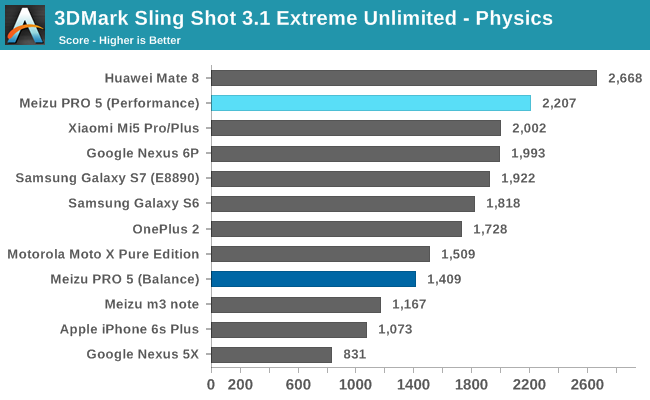
3DMark Sling Shot Extreme is another OpenGL ES 3.1 game simulation test that renders offscreen at a higher 1440p resolution than our other tests (the Physics test renders at 720p) and includes both GPU and CPU elements. Zeroing in on the graphics score, we see the PRO 5 outperform the phones using Adreno 418 and Mali-T880MP4 GPUs once again. The Nexus 6P and its Adreno 430 is 86% faster, however. The Xiaomi Mi5 (Adreno 530) and Galaxy S7 (Mali-T880MP12) perform about the same in this test with peak performance 2.66x higher than the PRO 5.
The Physics test measures CPU and memory performance by running an open source physics simulator. The PRO 5 and its Exynos 7420 SoC perform quite well, outperforming the newer Exynos 8890 and Snapdragon 820 SoCs in the Galaxy S7 and Xiaomi Mi5, respectively. Only the Mate 8’s Kirin 950 performs better. Because this is primarily a CPU test, we see a significant difference in performance between the PRO 5’s Performance and Balance modes, with the former showing a 57% advantage.
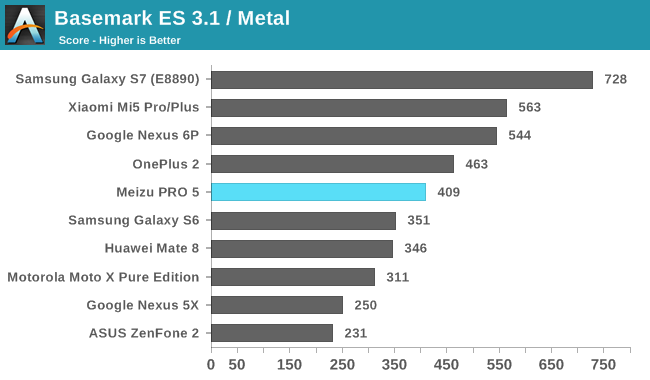
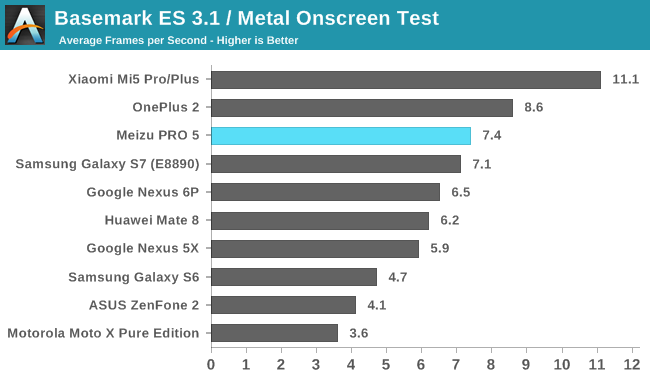
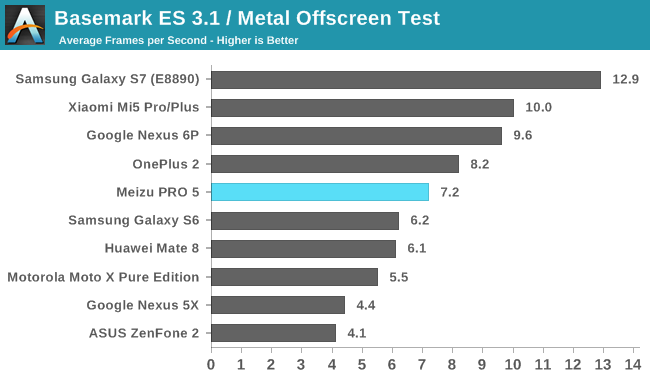
The previous performance trends hold true in Basemark ES 3.1. The Galaxy S7 at the top of the offscreen chart uses a Mali-T880MP12 GPU running at up to 650MHz. This gives it a peak, theoretical FP32 throughput of 234 GFLOPS, more than twice the Mate 8’s 108 GFLOPS and about 1.9x the PRO 5’s 124 GFLOPS, which is very close to the overall performance difference between the PRO 5 and Galaxy S7 (Exynos 8890).
The Meizu PRO 5 is certainly capable of playing modern games as long as they do not require hardware tessellation—its graphics driver currently does not support this feature. It cannot match the peak performance of the latest SoCs, but that level of performance is still overkill for the majority of games currently available. Its 1080p display, which is a negative mark overall, at least helps improve onscreen graphics performance.










80 Comments
View All Comments
Matt Humrick - Friday, June 24, 2016 - link
A few reasons:1) AnandTech has a global audience and we're trying to be more inclusive.
2) The Chinese OEMs are becoming increasingly relevant. Huawei is the third largest smartphone company by volume, for example.
3) Not all of the Chinese phones are bad.
4) Coincidence. Between a bevy of new device announcements and new relationships with companies, we received a windfall of devices from Chinese OEMs this spring. Also, some of our reviews are behind schedule (you may have noticed :), which jumbles the publishing order.
Will you continue to see reviews of devices from China? Yes. But we're not going to forget our readers in the US.
LiverpoolFC5903 - Tuesday, July 5, 2016 - link
Meizu is one of the best Chinese odms out there, with impeccable build quality and nice little innovations like the multifunctional home button that recognizes a tap as well as is mechanically click able.Love the fact that AT is doing more reviews of Chinese phones. Quite a few of Europeans are starting to import directly from China.
The beloved iPhone is also fully manufactured in China as well so readers would do well not to raise non existent quality issues.
justaway2 - Friday, June 24, 2016 - link
What's the point of reviewing phones that doesn't support North American LTE bands properly? This is a North American review site, after all. Band 7 and 38 are sparingly used in some spots in Canada, and 41 is only used on Sprint in the US. The rest are useless in NA.LTE band 1(2100), 3(1800), 7(2600), 38(2600), 39(1900), 40(2300), 41(2500)
It really bothers me how essentially no reviews ever talk about LTE band support.
BrokenCrayons - Friday, June 24, 2016 - link
This might be a surprise, but there are a lot of people on the planet that don't live in North America.justaway2 - Friday, June 24, 2016 - link
Is Anandtech not a North America-based site catering to a North American readership?There's 1.4B people living in China. Why isn't Anandtech publishing articles in Chinese?
Impulses - Friday, June 24, 2016 - link
I don't think the writers are all in NA, and they're all over the map so I dunno if you can say the site is l is based in any particular place anymore... I do remember reading requests for Chinese phone reviews for quite a while before they started doing them. I don't care one way or the other...BigLan - Friday, June 24, 2016 - link
It seems to be moving to more of a european site now rather than US based - most of the smartphone team is based in the UK iirc.Matt Humrick - Friday, June 24, 2016 - link
"What's the point of reviewing phones that doesn't support North American LTE bands properly?"See my answer above.
Speaking for myself (and I believe AnandTech in general), I always list band support for region specific devices. I usually will not for phones such as the iPhone or Samsung's Galaxy phones, because they are sold around the world and with all the different region/carrier models, band support is much less of an issue.
Andrei Frumusanu - Friday, June 24, 2016 - link
AnandTech is an English review site, not an North American one. NA readership accounts for less than half of total traffic.As the European mobile editor here I find such comments absolutely disappointing as such unfounded views are very much a core problem of why sometimes vendors are not willing to source devices as they see AT not as the "target market" even though we get plenty of comments requesting us to review these devices. And in the end, the last point is what matters, there absolutely is demand for us to review these devices and Chinese vendors are becoming more and more important both in terms of market-share but also in terms of innovation and product quality.
We will actually increase coverage of vendors such as Xiaomi or Meizu whose devices are focused on Asian markets because there is absolutely demand and interest in them.
more-or-less - Friday, June 24, 2016 - link
Just registered to say this - thank you :)We all wait for reviews of various brands as they are also getting popular across the globe. Those who don't want to read these reviews, they can easily read something else which they find interesting.